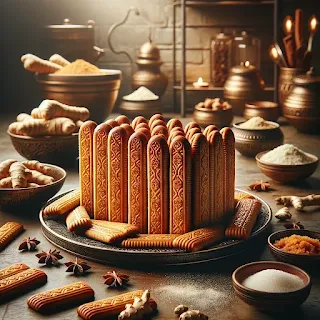Origin Story: Ginger Tea Biscuits
Ginger Tea Biscuits, also known as Biscuit Al-Nashader, are a traditional treat in Sudan and other parts of the Middle East, especially popular during Eid celebrations. These biscuits are characterized by their light, crunchy texture, achieved using baker's ammonia (nashader) as a leavening agent.
Historical Roots
The use of baker's ammonia in baking dates back centuries and was common in many traditional recipes before the advent of modern baking powder. This ingredient, known for creating a very light and crisp texture, is particularly suitable for biscuits like Biscuit Al-Nashader. The origins of these biscuits are rooted in Middle Eastern and North African culinary traditions, where spices and unique leavening agents were often used to create distinctive baked goods.
Cultural Significance
In Sudan and other Middle Eastern countries, Biscuit Al-Nashader is a staple during festive occasions, particularly Eid al-Fitr and Eid al-Adha. These biscuits are often prepared in large batches and shared with family and friends, symbolizing hospitality and celebration. The preparation and sharing of these biscuits are a beloved tradition, bringing families together in the kitchen.
Recipe Insights
Biscuit Al-Nashader typically includes simple ingredients such as flour, sugar, eggs, and butter, with ginger as the primary flavoring. The unique aspect of these biscuits is the use of baker's ammonia, which contributes to their signature texture. The dough is often rolled out, cut into shapes, and then baked until golden and crisp.
Adding ginger to these biscuits not only enhances their flavor but also provides a warming, aromatic quality that pairs perfectly with tea. Some variations of the recipe include additional flavorings like orange zest or vanilla, adding a unique twist to the traditional biscuits.
Personal Connection
My journey with Ginger Tea Biscuits began during an Eid celebration with friends from Sudan. The delightful aroma of ginger and the light, crispy texture of the biscuits made a lasting impression. Inspired by this experience, I set out to recreate the biscuits in my own kitchen. The key to perfecting the recipe was balancing the ginger flavor and achieving the right texture with baker's ammonia.
Sharing the Tradition
Today, Ginger Tea Biscuits are a favorite in my home, especially during festive occasions. They are the biscuits I bake when I want to share a taste of Middle Eastern tradition with my family and friends. Each batch is a celebration of cultural heritage and the joy of baking.
Ingredients:
Instructions:
- Preheat the oven to 350°F (175°C). Line a baking sheet with parchment paper.
- In a large bowl, cream together the butter, oil, and sugar until light and fluffy.
- In a separate bowl, sift together the flour, baking powder, ground ginger, ammonium bicarbonate, and salt.
- Gradually add the dry ingredients to the wet ingredients, alternating with the milk, until a soft dough forms.
- Roll out the dough on a lightly floured surface to about 1/4 inch thickness. Use a cookie cutter to cut out the biscuits and place them on the prepared baking sheet.
- Bake for 10-12 minutes, or until the edges are lightly golden. Allow the biscuits to cool on the baking sheet for a few minutes before transferring them to a wire rack to cool completely.
Pro Tips:
- Ensure the ammonium bicarbonate is finely ground for even distribution in the dough.
- Do not overbake the biscuits to maintain their crisp texture.
Secret Tips:
Serving Options:
Health Benefits:
Variations & Customization Options:
- Add a pinch of ground cardamom or cinnamon to the dough for a different flavor profile.
- Dip the cooled biscuits in melted chocolate for a sweet twist.

